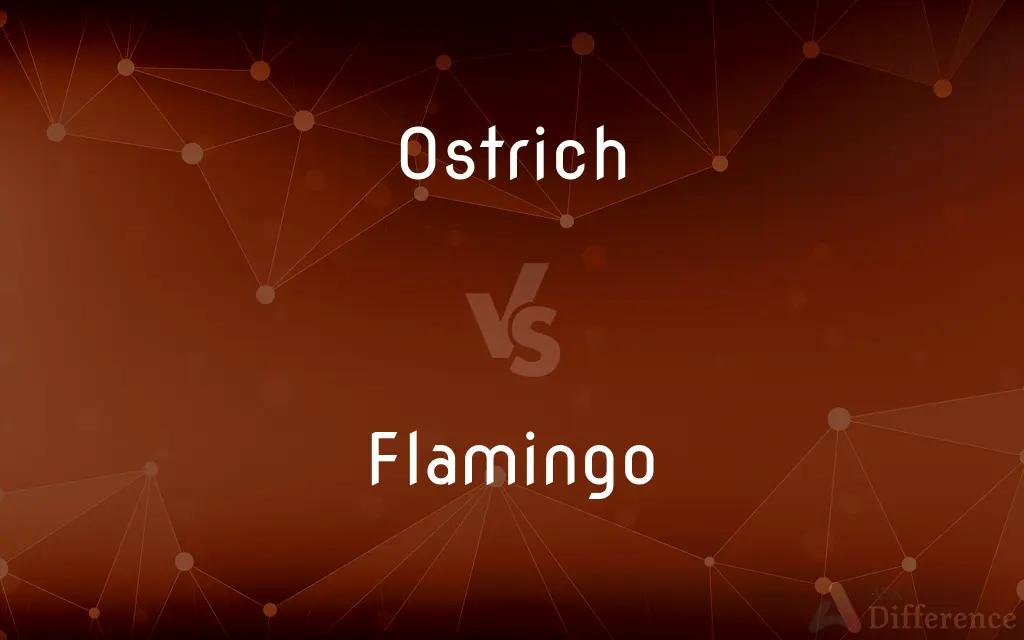Ostrich vs. Flamingo — What's the Difference?
By Tayyaba Rehman — Updated on November 2, 2023
Ostriches are large, flightless birds with long legs, native to Africa, whereas flamingos are pink-feathered, long-legged birds often seen standing on one leg, found in various regions globally.

Difference Between Ostrich and Flamingo
Table of Contents
ADVERTISEMENT
Key Differences
An ostrich is the world’s largest bird, native to Africa, and is known for its speed and inability to fly. Flamingos are famous for their pink plumage and can be found in regions of Africa, Asia, the Americas, and Europe. Both birds are distinctive in their habitats, with ostriches preferring dry savannas and flamingos frequenting alkaline or saline lakes and estuaries.
Ostriches boast a powerful build, with long necks and legs adapted for running, allowing them to reach speeds of up to 45 miles per hour. Flamingos, on the other hand, have slender necks and legs, with specialized beaks for filtering food from water. While ostriches lay the largest eggs of any bird species, flamingos are known for their complex mating dances and the unique coloration of their feathers, derived from their diet of brine shrimp and algae.
The ostrich has a diverse diet, consuming everything from seeds to small animals. Flamingos, conversely, are filter feeders, relying heavily on their beak's unique structure to sift food from mud and water. The social structures also differ, as ostriches can form herds that may include other grazing animals, whereas flamingos are highly social, living in large colonies that can number in the thousands.
In terms of reproduction, ostriches practice communal nesting, where several females may lay their eggs in the dominant female's nest, but only the dominant female and male typically tend to the nest. Flamingos build individual mud mound nests where both parents take turns incubating a single egg. The parenting strategies reflect their environments and social behaviors, with each bird species adapting to maximize their offspring's survival chances.
Physiologically, ostriches are robust, with powerful legs equipped with two toes that aid in their terrestrial lifestyle. Flamingos are more delicate, with their long, stilt-like legs and webbed feet, adaptations that allow them to wade into deeper waters. While the ostrich’s physical prowess is in its speed and strength, the flamingo’s is in its ability to exploit aquatic food sources that other birds cannot access.
ADVERTISEMENT
Comparison Chart
Size and Build
The largest bird, flightless, strong legs.
Medium-sized, slender, capable of flight.
Habitat
Dry savannas of Africa.
Alkaline/saline lakes, estuaries worldwide.
Coloration
Mostly brown or grey feathers.
Pink to red feathers due to diet.
Leg Structure
Two toes, adapted for running.
Webbed feet, adapted for wading.
Diet
Omnivorous, seeds to small animals.
Filter-feeders, primarily brine shrimp and algae.
Compare with Definitions
Ostrich
The bird species that lays the largest eggs.
An ostrich egg can make an omelet big enough to feed a dozen people.
Flamingo
A bird whose color comes from its algae and shrimp diet.
The flamingo’s vibrant hue is thanks to the carotenoids in its diet.
Ostrich
A large flightless bird known for its speed and size.
The ostrich sprinted across the savanna, leaving a cloud of dust behind.
Flamingo
It has long, stilt-like legs and webbed feet for wading.
With its long legs, the flamingo waded deeper than other birds could.
Ostrich
A symbol of speed on land among birds.
The racehorse of the avian world, the ostrich can outrun predators.
Flamingo
A wading bird with pink feathers and a distinctive beak.
The flamingo sifted through the water, searching for its next meal.
Ostrich
Struthio is a genus of birds in the order Struthioniformes, whose members are the ostriches. It is part of the infra-class Palaeognathae, a diverse group of flightless birds also known as ratites that includes the emus, rheas, and kiwis.
Flamingo
Known for its one-legged stance and social colonies.
A group of flamingos stood in the shallow water, balancing gracefully.
Ostrich
Either of two large, swift-running flightless birds (Struthio camelus or S. molybdophanes) of Africa, characterized by a long bare neck, small head, and two-toed feet. Ostriches are the largest living birds.
Flamingo
Inhabits saline waters where it feeds and breeds.
Flamingos flocked to the saline lake, their preferred breeding ground.
Ostrich
A rhea.
Flamingo
Flamingos or flamingoes are a type of wading bird in the family Phoenicopteridae, the only bird family in the order Phoenicopteriformes. Four flamingo species are distributed throughout the Americas, including the Caribbean, and two species are native to Africa, Asia, and Europe.
Ostrich
One who tries to avoid disagreeable situations by refusing to face them.
Flamingo
Any of several large wading birds of the family Phoenicopteridae, primarily of tropical regions, having reddish or pinkish plumage, long legs, a long flexible neck, and a bill turned downward at the tip.
Ostrich
(ornithology) A large flightless bird of the genus Struthio.
Flamingo
A moderate reddish orange.
Ostrich
The most widespread species of the genus, known as the common ostrich (Struthio camelus).
Flamingo
A wading bird of the family Phoenicopteridae.
Ostrich
(figurative) One who buries one's head in the sand instead of acknowledging problems.
Flamingo
A deep pink color tinged with orange, like that of a flamingo.
Ostrich
(golf) The hypothetical completion of a hole five strokes under par (a quintuple birdie, quadruple eagle, triple albatross, or double condor).
Flamingo
Of a deep pink color tinged with orange, like that of a flamingo.
Ostrich
A large bird of the genus Struthio, of which Struthio camelus of Africa is the best known species. It has long and very strong legs, adapted for rapid running; only two toes; a long neck, nearly bare of feathers; and short wings incapable of flight. The adult male is about eight feet high.
Flamingo
Any bird of the genus Phœnicopterus. The flamingoes have webbed feet, very long legs, and a beak bent down as if broken. Their color is usually red or pink. The American flamingo is P. ruber; the European is P. antiquorum.
Ostrich
A person who refuses to face reality or recognize the truth (a reference to the popular notion that the ostrich hides from danger by burying its head in the sand)
Flamingo
Large pink to scarlet web-footed wading bird with down-bent bill; inhabits brackish lakes
Ostrich
Fast-running African flightless bird with two-toed feet; largest living bird
Ostrich
A bird with long legs and neck, native to Africa.
Tourists watched in awe as the ostrich approached their safari vehicle.
Ostrich
An omnivorous bird with diverse dietary habits.
The ostrich pecked curiously at the shiny object, mistaking it for food.
Common Curiosities
What is the main diet of an ostrich?
Ostriches are omnivores; they eat plants, seeds, and small animals.
Are flamingos always pink?
No, flamingos are born grey; their pink color comes from their diet.
Can ostriches fly?
No, ostriches are flightless due to their size and wing structure.
Where can you find ostriches in the wild?
Ostriches are native to various African savanna and desert regions.
Why do flamingos stand on one leg?
Flamingos may stand on one leg to conserve body heat and rest.
How fast can an ostrich run?
An ostrich can run at speeds of up to 45 miles per hour.
Can flamingos fly?
Yes, flamingos can fly and often travel long distances.
How long do ostriches live?
Ostriches can live up to 40-45 years in the wild and longer in captivity.
Are ostriches the largest bird in the world?
Yes, ostriches are the largest and heaviest birds on Earth.
Where do flamingos live?
Flamingos inhabit warm, watery regions on several continents.
What is a group of ostriches called?
A group of ostriches is known as a flock or herd.
What do flamingos eat?
Flamingos mainly eat brine shrimp and algae, which they filter from water.
What is a group of flamingos called?
A group of flamingos is called a flamboyance or colony.
How do ostriches defend themselves?
Ostriches use their powerful legs to run away or kick as defense.
Do flamingos mate for life?
Flamingos are not typically monogamous and may change mates over their lifetime.
Share Your Discovery

Previous Comparison
Responsible vs. Irresponsible
Next Comparison
Determination vs. TenacityAuthor Spotlight
Written by
Tayyaba RehmanTayyaba Rehman is a distinguished writer, currently serving as a primary contributor to askdifference.com. As a researcher in semantics and etymology, Tayyaba's passion for the complexity of languages and their distinctions has found a perfect home on the platform. Tayyaba delves into the intricacies of language, distinguishing between commonly confused words and phrases, thereby providing clarity for readers worldwide.













































